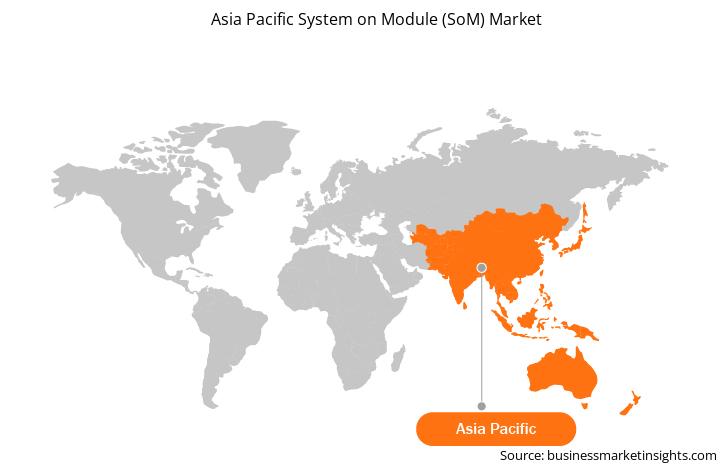The System on Module (SoM) market in Asia Pacific is expected to grow from US$ 792.06 million in 2022 to US$ 1,405.29 million by 2028. It is estimated to grow at a CAGR of 10.0% from 2022 to 2028.
The Asia Pacific system on module market is anticipated to grow at a significant CAGR during the forecast period. The projected growth is attributed to the rise in government initiatives to support the ongoing industrialization and increasing demand for efficient electronic Components, such as processors, boards, and systems in modules from the consumer electronics sector. Government support to boost the regional electronics & semiconductors sector is anticipated to provide significant growth opportunities to the market.
With the 2014 National Integrated Circuit Industry Development Guidelines, the State Council of China set the goal of becoming a global leader in all segments of the semiconductor industry by 2030. In addition, through its Made in China 2025 initiative, the country aims to achieve the standards of advanced semiconductor manufacturing as a vital component of its future economy.
The Chinese government is spending aggressively on investments, acquisitions, and talent recruitment to encourage the proliferation of the semiconductors industry, which is anticipated to boost the growth of the systems on modules market. Countries, such as Taiwan and India are focusing on developing their manufacturing and industrial automation sectors. Foreign investments, coupled with the establishment of facilities for global players and the rise of startups, are anticipated to positively impact the system on module market, especially in China. The flourishing IT and services infrastructure in China and India is supporting the development and adoption of highly efficient embedded computing solutions, which would provide growth impetus to the system on module market in the coming years.
Strategic insights for the Asia Pacific System on Module (SoM) provides data-driven analysis of the industry landscape, including current trends, key players, and regional nuances. These insights offer actionable recommendations, enabling readers to differentiate themselves from competitors by identifying untapped segments or developing unique value propositions. Leveraging data analytics, these insights help industry players anticipate the market shifts, whether investors, manufacturers, or other stakeholders. A future-oriented perspective is essential, helping stakeholders anticipate market shifts and position themselves for long-term success in this dynamic region. Ultimately, effective strategic insights empower readers to make informed decisions that drive profitability and achieve their business objectives within the market. The geographic scope of the Asia Pacific System on Module (SoM) refers to the specific areas in which a business operates and competes. Understanding local distinctions, such as diverse consumer preferences (e.g., demand for specific plug types or battery backup durations), varying economic conditions, and regulatory environments, is crucial for tailoring strategies to specific markets. Businesses can expand their reach by identifying underserved areas or adapting their offerings to meet local demands. A clear market focus allows for more effective resource allocation, targeted marketing campaigns, and better positioning against local competitors, ultimately driving growth in those targeted areas.
Asia Pacific System on Module (SoM) Strategic Insights

Asia Pacific System on Module (SoM) Report Scope
Report Attribute
Details
Market size in 2022
US$ 792.06 Million
Market Size by 2028
US$ 1,405.29 Million
Global CAGR (2022 - 2028)
10.0%
Historical Data
2020-2021
Forecast period
2023-2028
Segments Covered
By Processor Type
By Application
By Standard
Regions and Countries Covered
Asia-Pacific
Market leaders and key company profiles
Asia Pacific System on Module (SoM) Regional Insights

Asia Pacific System on Module (SoM) Market Segmentation
The Asia Pacific system on module (SoM) market is segmented by component, hardware type, standard, application, and country. The market based on component is bifurcated into hardware and software. The hardware segment is dominating the market in 2022. Based on hardware type, the market is segmented into ARM, X86, Power, FPGA, GPU, DSP, and RISC-V. The ARM segment dominated the market in 2022. Based on standard, the market is segmented into Qseven, COMExpress, and SMARC. The Qseven segment dominated the market in 2022. Based on application, the market is segmented into industrial automation, entertainment, medical, transportation, test and measurement, video application, and others. The industrial automation segment dominated the market in 2022. Based on country, the market is segmented into Australia, China, India, Japan, South Korea, and the rest of Asia Pacific. Further, China dominated the market in 2022.
A few key players dominating the Asia Pacific System on Module (SoM) market are AAEON; Advantech Co. Ltd.; Axiomtek Co., Ltd.; congatec GmbH; Connect Tech Inc.; Emcraft Systems; Microchip Technology, Inc.; MIPS Technologies Inc.; National Instruments Corporation; Segate Technology LLC; SiFive Inc.; and SoMLabs.
The Asia Pacific System on Module (SoM) Market is valued at US$ 792.06 Million in 2022, it is projected to reach US$ 1,405.29 Million by 2028.
As per our report Asia Pacific System on Module (SoM) Market, the market size is valued at US$ 792.06 Million in 2022, projecting it to reach US$ 1,405.29 Million by 2028. This translates to a CAGR of approximately 10.0% during the forecast period.
The Asia Pacific System on Module (SoM) Market report typically cover these key segments-
The historic period, base year, and forecast period can vary slightly depending on the specific market research report. However, for the Asia Pacific System on Module (SoM) Market report:
The Asia Pacific System on Module (SoM) Market is populated by several key players, each contributing to its growth and innovation. Some of the major players include:
The Asia Pacific System on Module (SoM) Market report is valuable for diverse stakeholders, including:
Essentially, anyone involved in or considering involvement in the Asia Pacific System on Module (SoM) Market value chain can benefit from the information contained in a comprehensive market report.